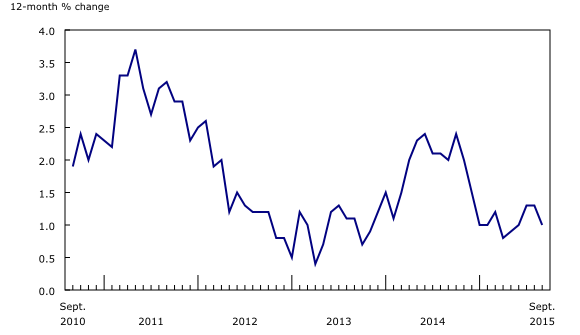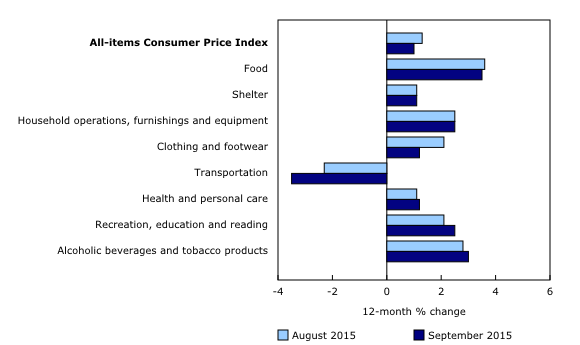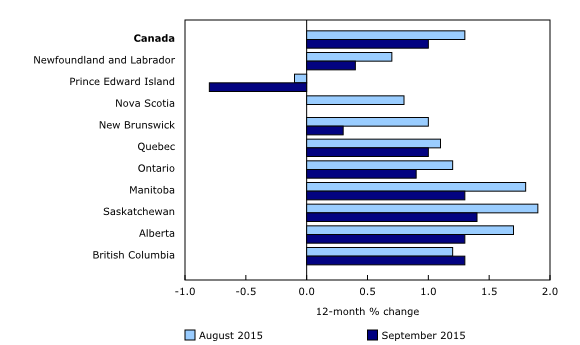Consumer Price Index, September 2015
Archived Content
Information identified as archived is provided for reference, research or recordkeeping purposes. It is not subject to the Government of Canada Web Standards and has not been altered or updated since it was archived. Please "contact us" to request a format other than those available.
Released: 2015-10-23
September 2015
1.0% 
(12-month change)
The Consumer Price Index (CPI) rose 1.0% in the 12 months to September, after increasing 1.3% in August.
The smaller year-over-year increase in the CPI in September compared with August was mostly attributable to an 18.8% year-over-year decline in gasoline prices in September, following a 12.6% decrease the previous month.
12-month change in the major components
Prices were up in seven of the eight major components on a year-over-year basis in September, with the rise in the CPI led by higher prices for food. Increases in the household operations, furnishings and equipment index and the shelter index also contributed to higher consumer prices. The transportation index, which includes gasoline, recorded its 11th consecutive year-over-year decline.
Consumers paid 3.5% more for food in September compared with the same month a year ago. Prices for food purchased from stores were up 3.9% year over year in September. Prices for fresh vegetables increased more on a year-over-year basis in September (+11.5%) than in August (+7.7%). The meat index rose 4.4% year over year in September, following a 6.3% increase in August. In the 12 months to September, prices for food purchased from restaurants were up 2.7%.
The index for recreation, education and reading increased 2.5% in the 12 months to September, after rising 2.1% the previous month. This acceleration was led by the traveller accommodation index, which was up 10.8% on a year-over-year basis in September, after increasing 7.4% in August. Tuition fees were up 2.8% in September compared with the same month a year earlier.
The clothing and footwear index was up 1.2% in the 12 months to September, after rising 2.1% the previous month. This deceleration was partly attributable to the men's clothing index and children's clothing index, which registered smaller year-over-year increases in September than in August. Additionally, the index for women's clothing recorded no year-over-year change, after posting an increase the previous month.
The transportation index declined 3.5% in the 12 months to September, after decreasing 2.3% in August. This larger year-over-year decrease was mainly attributable to gasoline prices, which fell 7.9% on a month-over-month basis in September, a larger monthly decrease than the index recorded in the same month the previous year. In contrast, the purchase of passenger vehicles index was up 1.6% in the 12 months to September, after increasing 0.6% in August.
12-month change in the provinces
Consumer prices rose in eight provinces in the 12 months to September. Saskatchewan posted the largest increase, followed by Manitoba, Alberta and British Columbia. The CPI in Prince Edward Island registered its 10th consecutive year-over-year decline.
In every province, prices for gasoline decreased more on a year-over-year basis in September than in August.
The CPI in Saskatchewan was up 1.4% in the 12 months to September, after increasing 1.9% in August. The index for passenger vehicle insurance premiums recorded a smaller year-over-year increase in September (+0.3%) than in August (+7.7%). Traveller accommodation prices rose 3.5% in the 12 months to September, a smaller increase than at the national level.
In Prince Edward Island, the CPI decreased 0.8% in the 12 months to September, after declining 0.1% the previous month. This larger year-over-year decrease was partly attributable to the fuel oil index, which declined 31.3% in September, following a 23.9% decrease in August. The basket weight of fuel oil is 10 times greater in Prince Edward Island than in Canada as a whole.
British Columbia was the sole province to show a larger year-over-year increase in its CPI in September (+1.3%) than in August (+1.2%). Prices for men's clothing were up 5.1% in the 12 months to September, after falling 0.2% the previous month. In addition, the video and audio subscription services index was up 5.0% on a year-over-year basis in September, after rising 0.5% the previous month.
Seasonally adjusted monthly Consumer Price Index decreases
On a seasonally adjusted monthly basis, the CPI decreased 0.2% in September, after posting no change in August.
In September, two of the eight major components decreased on a seasonally adjusted monthly basis. The seasonally adjusted index for shelter posted no change.
The largest decrease in September was recorded in the seasonally adjusted transportation index, which fell 1.4%. The seasonally adjusted clothing and footwear index (-0.1%) also declined.
Conversely, the seasonally adjusted food index and the seasonally adjusted recreation, education and reading index both rose 0.4%.
Bank of Canada's core index
The Bank of Canada's core index was up 2.1% in the 12 months to September, matching the increase in August.
The seasonally adjusted core index was up 0.1% on a monthly basis in September, after increasing 0.2% in August.
Note to readers
A seasonally adjusted series is one from which seasonal movements have been eliminated. Users employing Consumer Price Index (CPI) data for indexation purposes are advised to use the unadjusted indexes. For more information on seasonal adjustment, see Seasonally adjusted data – Frequently asked questions.
The Bank of Canada's core index excludes eight of the CPI's most volatile components (fruit, fruit preparations and nuts; vegetables and vegetable preparations; mortgage interest cost; natural gas; fuel oil and other fuels; gasoline; inter-city transportation; and tobacco products and smokers' supplies) as well as the effects of changes in indirect taxes on the remaining components.
For a more detailed report of the CPI, consult the publication The Consumer Price Index.
Next release
The CPI for October will be released on November 20.
Products
The September 2015 issue of The Consumer Price Index, Vol. 94, no. 9 (62-001-X), is now available from the Browse by key resource module of our website under Publications.
More information about the concepts and use of the Consumer Price Index (CPI) is available in The Canadian Consumer Price Index Reference Paper (62-553-X).
For information on the history of the CPI in Canada, consult the publication Exploring the first century of Canada's Consumer Price Index (62-604-X).
A video providing an overview of the CPI is available on Statistics Canada's YouTube channel.
Contact information
For more information, or to enquire about the concepts, methods or data quality of this release, contact us (toll-free 1-800-263-1136; 514-283-8300; infostats@statcan.gc.ca) or Media Relations (613-951-4636; statcan.mediahotline-ligneinfomedias.statcan@canada.ca).
- Date modified:





